Complete Solutions to REVIEW QUESTIONS of chapter CHEMICAL COORDINATION IN PLANTS of Class 10 book with complete answers and questions
| Class 10 | BIOLOGY |
| Chapter | CHEMICAL COORDINATION IN PLANTS |
| EVERGREEN PUBLICATION | REVIEW QUESTIONS |
| Number Of Questions | 100 |
| Academic Year | 2023-24 |
Name the following:
A growth inhibitor.
View SolutionName the following:
A gaseous hormone.
View SolutionName the following:
The tropic movement in response to the stimulus of the chemicals.
View SolutionName the following:
Growth movements made by plants in response to contact (touch) with a solid object.
View SolutionName the following:
A flower bud which is positively geotropic but when the flower opens it shows negative geotropism
View SolutionName the following:
A special apparatus in which if a plant is rotated neutralizes the effect of gravity.
View SolutionName the following:
The movement of plant parts in response to the force of gravity.
View SolutionName the following:
A plant hormone which breaks the dormancy of buds and seeds.
View SolutionChoose the correct alternative :
Which is an auxin?
ATP
Pyruvic acid
Phosphoglyceric acid
Indole acetic acid
View SolutionChoose the correct alternative :
The growth rate is highest in which light?
1. Red Light
2. White light
3. Green light
4. Blue light
View SolutionChoose the correct alternative :
Plant hormones are:
1. Growth regulators
2. Growth promoters
3. Growth inhibitors
4. All of these
View SolutionChoose the correct alternative :
Geotropic response is perceived by:
1. Mature roots
2. Elongating roots
3. Root cap
4. Root hairs
View SolutionChoose the correct alternative :
Which one of the following is a natural growth inhibitor ?
1. NAA
2. ABA
3. IAA
4. GA
View SolutionChoose the correct alternative :
Gibberellin promotes cell division and elongation in:
1. Leaves
2. Roots
3. Shoots
4. All of these
View SolutionChoose the correct alternative :
Movements induced in plants by external Movements induced in plants by external
View SolutionChoose the correct alternative :
Auxins were first discovered by which scientist while experimenting on oat plant (Avena sativa) ?
1. F W Went
2. Darwin
3. Boysen Jensen
4. None of these
View SolutionFill in the blanks with suitable words :
All changes that an organism goes through during its life cycle is called …………
View SolutionFill in the blanks with suitable words :
Synthetic auxins are used as ………
View SolutionFill in the blanks with suitable words :
Movement of fungal hyphae towards ……… and peptones is called chemotropism.
View SolutionFill in the blanks with suitable words :
……….. are situated below the bark and is responsible for increase in the diameter of the stem.
View SolutionFill in the blanks with suitable words :
………. And ……… are growth inhibitors.
View SolutionFill in the blanks with suitable words :
………… are unwanted plants growing in a field alongwith a crop.
View SolutionFill in the blanks with suitable words :
Auxins were isolated initially from the urine of humans who suffered from a disease called …………
View SolutionFill in the blanks with suitable words :
………… promote seed germination in cereals and lettuce.
View SolutionFill in the blanks with suitable words :
In Ivy and bean ……….. promotes rooting of stem cuttings
View SolutionFill in the blanks with suitable words :
Chlamydomonas and volvox show movement by means of ..........
View SolutionFill in the blanks with suitable words :
Mosses and ……… are ciliated and move about in water.
View SolutionFill in the blanks with suitable words :
Roots are ……….. hydrotropic as they bend towards the source of water.
View SolutionMention if the following statements are true or false,
By application of gibberellins bolting can be induced artificially in cabbage.
View SolutionMention if the following statements are true or false,
The examples of synthetic auxins are IAA and IBA.
View SolutionMention if the following statements are true or false,
The secondary roots and branches place themselves at right angles to the force of gravity and are called diaphototropic.
View SolutionMention if the following statements are true or false,
Gibberellins were first isolated from an algae
View SolutionMention if the following statements are true or false,
Hydrotropic movements are more powerful
View SolutionMention if the following statements are true or false,
The growth regulators are called as Phytohormones.
View SolutionMention if the following statements are true or false,
In flowering plant, a period of vegetative phase is followed by reproductive phase.
View SolutionMention if the following statements are true or false,
Senescence is separation of leaves, flowers and fruits from the plant body.
View SolutionMention if the following statements are true or false,
Some organs of plants do not respond to geotropic stimulus and are called Ageotropic.
View SolutionMention if the following statements are true or false,
Lateral meristems are situated below the bark and is responsible for increase in the length of the stem.
View SolutionMention if the following statements are true or false,
Gibberellins are basic in nature.
View SolutionMention if the following statements are true or false,
In unicellular plants, there is overall growth and not confined to any specific region but in multicellular plants, growth is restricted to specific regions having meristematic cells.
View SolutionGive reasons for the following facts:
Dry seeds do not germinate.
View SolutionGive reasons for the following facts:
Plants bend towards the source of light.
View SolutionGive reasons for the following facts:
When apical bud is removed, the next axial bud begins to grow.
View SolutionGive reasons for the following facts:
Some plants flower in summer and some in winters.
View SolutionGive reasons for the following facts:
Rice plants infected by fungus Gibberella fujikuroi grow foolishly tall
View SolutionGive reasons for the following facts:
IAA is not the only naturally occurring auxins.
View SolutionGive reasons for the following facts:
Auxins fail to enhance the growth of intact plants
View SolutionMatch the following:
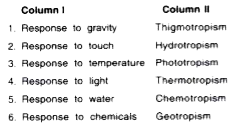
View SolutionThe diagram given below is an instrument which is used to eliminate the effect of gravity

Name the instrument.
View SolutionThe diagram given below is an instrument which is used to eliminate the effect of gravity
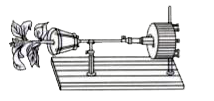
What is the use of this instrument in this experiment?
View SolutionThe diagram given below is an instrument which is used to eliminate the effect of gravity
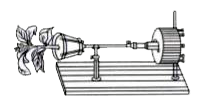
Why does the plant grow straight?
View SolutionThe diagram shows some movement in plants.
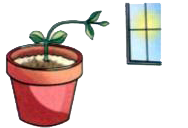
What is the aim of the experiment?
View SolutionThe diagram shows some movement in plants.

Why does the plant move towards the light source?
View SolutionThe diagram shows some movement in plants.
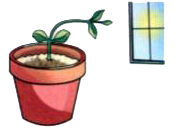
What is geotropism?
View SolutionThe diagram shows some movement in plants.
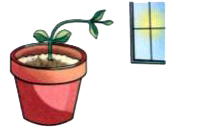
What are tropic movements?
View SolutionThe diagram shows some movement in plants.
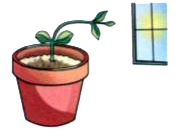
What will happen if the light source is removed from the experiment?
View SolutionList any four uses of auxins.
View SolutionWhat is the full form of: IAA, NAA and IBA?
View SolutionIn a wheat field, some broad leaved weeds were seen by a farmer. Which plant hormone would you suggest to get rid of them?
View SolutionDefine growth regulators.
View SolutionExplain briefly apical dominance. Name the hormone that controls it.
View SolutionGive one significant difference between each of the following:
Geotropism and Phototropism
View SolutionGive one significant difference between each of the following:
Auxins and Gibberellins
View SolutionGive one significant difference between each of the following:
Plant growth regulators and Plant Growth Inhibitors
View SolutionGive one significant difference between each of the following:
Thigmotropism and Chemotropism
View SolutionGive one significant difference between each of the following:
Movement and Locomotion
View SolutionExplain what would happen if:
Gibberellins are applied to cabbage plant.
View SolutionExplain what would happen if:
Cytokinins are applied to a plant externally.
View SolutionExplain what would happen if:
Ethylene is sprayed on a mango tree
View SolutionExplain what would happen if:
A flower is emasculated and auxin is applied to its stigma
View SolutionExplain what would happen if:
A plant is kept near an open window
View SolutionExplain the following terms:
Bolting
View SolutionExplain the following terms:
Parthenocarpy
View SolutionExplain the following terms:
Morphogenesis
View SolutionExplain the following terms:
Differntiation
View SolutionExplain the following terms:
Phytohormone
View SolutionThe chemical substance P is made and secreted by the meristematic tissue at the tip of stem (or shoot) of a plant. The chemical substance P is responsible for a phenomenon Q in plants in which the stem bends towards the source of light. The same chemical substance P has an opposite effect on the root of a plant. It causes the root of a plant to bend away from the source of light in a process called R.
What is the chemical substance P ?
View SolutionThe chemical substance P is made and secreted by the meristematic tissue at the tip of stem (or shoot) of a plant. The chemical substance P is responsible for a phenomenon Q in plants in which the stem bends towards the source of light. The same chemical substance P has an opposite effect on the root of a plant. It causes the root of a plant to bend away from the source of light in a process called R.
State whether P prefers to remain in the sunlit side of a stem or in shade.
View SolutionThe chemical substance P is made and secreted by the meristematic tissue at the tip of stem (or shoot) of a plant. The chemical substance P is responsible for a phenomenon Q in plants in which the stem bends towards the source of light. The same chemical substance P has an opposite effect on the root of a plant. It causes the root of a plant to bend away from the source of light in a process called R.
What is the effect of substance P on the rate of growth of
(a) a root and (b) a stem?
View SolutionThe chemical substance P is made and secreted by the meristematic tissue at the tip of stem (or shoot) of a plant. The chemical substance P is responsible for a phenomenon Q in plants in which the stem bends towards the source of light. The same chemical substance P has an opposite effect on the root of a plant. It causes the root of a plant to bend away from the source of light in a process called R.
What is the name of the process
(a) Q and (b) R ?
View SolutionThe chemical substance P is made and secreted by the meristematic tissue at the tip of stem (or shoot) of a plant. The chemical substance P is responsible for a phenomenon Q in plants in which the stem bends towards the source of light. The same chemical substance P has an opposite effect on the root of a plant. It causes the root of a plant to bend away from the source of light in a process called R.
What is the general name of the chemical substance like P ? Name another substance which belongs to this class of chemical substances.
View SolutionWrite the functions of Phytoharmones.
View SolutionWhat is meant by positive tropism and negative tropism?
View SolutionWhat is tendril? Name any two types of tendrils.
View SolutionExpand the following biological abbreviations
(i) (ABA)
View SolutionExpand the following biological abbreviations
(ii) (IAA)
View SolutionGiven below is an experimental setup to demonstrate a particular tropic movement in germinating seeds. Study the diagram and answer the questions that follow :

Label the parts 1 and 2.
View SolutionGiven below is an experimental setup to demonstrate a particular tropic movement in germinating seeds. Study the diagram and answer the questions that follow :

Name the tropic movement shown by part 1.
View SolutionGiven below is an experimental setup to demonstrate a particular tropic movement in germinating seeds. Study the diagram and answer the questions that follow :

Part 1 is affected by two stimuli. Name them. Which one of the two is stronger
View SolutionGiven below is an experimental setup to demonstrate a particular tropic movement in germinating seeds. Study the diagram and answer the questions that follow :

What is Thigmotropism 2 Give one example,
View SolutionGiven below is an experimental setup to demonstrate a particular tropic movement in germinating seeds. Study the diagram and answer the questions that follow :

What is meant by Positive and negative tropic movements in plants
View SolutionState the main functions of the following: Cytokinins
View SolutionWhat is Parthenocarpy ? Give one example.
View SolutionMatch the following

View SolutionName the following:
A gaseous hormone.
View SolutionName the following:
The tropic movement in response to the stimulus of the chemicals.
View SolutionName the following:
Growth movements made by plants in response to contact (touch) with a solid object.
View SolutionName the following:
A flower bud which is positively geotropic but when the flower opens it shows negative geotropism
View SolutionName the following:
A special apparatus in which if a plant is rotated neutralizes the effect of gravity.
View SolutionName the following:
The movement of plant parts in response to the force of gravity.
View Solution
REVIEW QUESTIONS questions and complete solutions for chapter CHEMICAL COORDINATION IN PLANTS of EVERGREEN BIOLOGY (ENGLISH) of Class 10